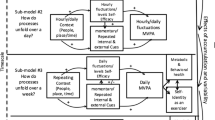Abstract
This special section of the Perspectives on Behavior Science focuses on health, technology, and behavior science. The aim is to provide reviews and empirical research that integrates the latest technological innovations and behavior science. The selected articles are categorized into contributions in which technology is used to study health-related behavior and articles on the use of technology to deliver health behavior interventions. The contributors in this special section demonstrate that behavior science can aid an understanding of why people do or do not engage in a healthy lifestyle and help identify what is needed to design a successful health behavior intervention through the use of technology.
Similar content being viewed by others
References
Briefel, R. R., & Johnson, C. L. (2004). Secular trends in dietary intake in the United States. Annual Review of Nutrition, 24, 401–431.
Cassey, H. J., Washio, Y., & Hantula, D. A. (2016). The good nutrition game: Extending the good behavior game to promote fruit and vegetable intake. Delaware Medical Journal, 88(11), 342–345.
Dallery, J., Kurti, A., & Erb, P. (2015). A new frontier: Integrating behavioral and digital technology to promote health behavior. The Behavior Analyst, 38(1), 19–49. https://doi.org/10.1007/s40614-014-0017-y.
Glanz, K., & Bishop, D. B. (2010). The role of behavioral science theory in development and implementation of public health interventions. Annual Review of Public Health, 31, 399–418.
Glanz, K., Rimer, B. K., & Viswanath, K. (2008). Health behavior and health education: Theory, research, and practice. Hoboken, NJ: Wiley.
Hustyi, K. M., Normand, M. P., Larson, T. A., & Morley, A. J. (2012). The effect of outdoor activity context on physical activity in preschool children. Journal of Applied Behavior Analysis, 45(2), 401–405.
Nielsen, S. J., Siega-Riz, A. M., & Popkin, B. M. (2002). Trends in food locations and sources among adolescents and young adults. Preventive Medicine, 35(2), 107–113.
Rachlin, H. (2000). The science of self-control. Cambridge, MA: Harvard University Press.
Ruckenstein, M., & Schüll, N. D. (2017). The datafication of health. Annual Review of Anthropology, 46, 261–278.
Schroeder, S. A. (2007). We can do better: Improving the health of the American people. New England Journal of Medicine, 357(12), 1221–1228.
Author information
Authors and Affiliations
Corresponding author
Additional information
Publisher’s Note
Springer Nature remains neutral with regard to jurisdictional claims in published maps and institutional affiliations.
Rights and permissions
About this article
Cite this article
Sigurdsson, V., Fagerstrøm, A. An Introduction to the Special Section on “Health, Technology, & Behavior Science”. Perspect Behav Sci 43, 445–449 (2020). https://doi.org/10.1007/s40614-020-00267-7
Published:
Issue Date:
DOI: https://doi.org/10.1007/s40614-020-00267-7




